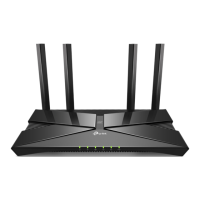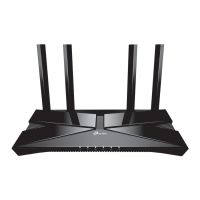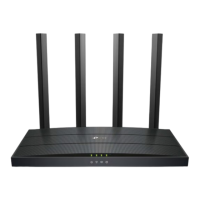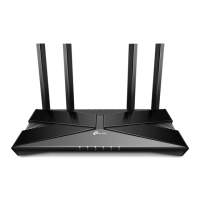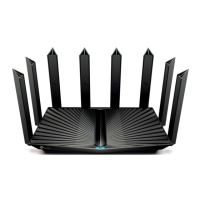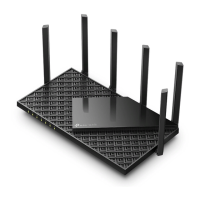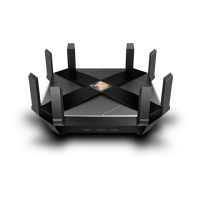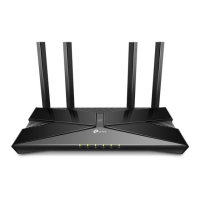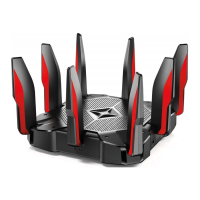Do you have a question about the TP-Link Archer AX4400 and is the answer not in the manual?
Details the router's advanced Wi-Fi 6 technology, including OFDMA and 1024QAM for enhanced throughput and efficiency.
Explains the physical layout, including details on the top, back, and side panels and their components.
Provides guidelines on optimal router placement, avoiding moisture, heat, and electromagnetic interference.
Step-by-step instructions for connecting the modem, power adapter, and computer to set up the router's hardware.
Explains how to access the router's web utility via a browser and set a secure login password.
Guides setup for internet connection, including optional TP-Link Cloud service registration.
Instructions for using the TP-Link Tether app on mobile devices to quickly set up the router and connect to the internet.
Details manual configuration for Dynamic IP, Static IP, and PPPoE based on ISP information.
Configures the router to extend a wired network wirelessly, transforming it into an access point.
Configures IPv6 connection types like Static IP, Dynamic IP, PPPoE, and tunnels.
Instructions on creating a new TP-Link ID for managing cloud services and the router.
Guides on updating the email address and password associated with your TP-Link ID.
Explains adding or removing TP-Link IDs to manage the router, distinguishing Admin and User roles.
Details using the TP-Link Tether app to remotely manage router functions and settings.
Customizes network name (SSID), password, security, and advanced features like OFDMA and TWT.
Schedules automatic on/off for the wireless network to save power or manage usage.
Explains secure device connection using Wi-Fi Protected Setup (WPS) via PIN or button push.
Covers advanced wireless configurations like WMM, AP Isolation, Airtime Fairness, and Beacon Interval.
Guides on setting up a separate Wi-Fi network for guests, customizing SSID, security, and password.
Configures guest network permissions, allowing or restricting guest communication with the local network.
Instructions for accessing files on USB devices connected to the router, locally and remotely.
Enables viewing photos, music, and movies from USB storage on DLNA-supported devices.
Configures Time Machine backups from a Mac to a USB device connected to the router.
Utilizes HomeShield features like Network Analysis, IoT Protection, Intrusion Prevention, and DDoS Protection.
Sets restrictions on internet access for family members, including content blocking and time limits.
Provides tools for analyzing and optimizing network performance, including reports, QoS, and scanning.
Guides on creating a unified Wi-Fi network by connecting OneMesh extenders for seamless roaming.
Details viewing and managing mesh devices and connected clients within the OneMesh network.
Explains SPI Firewall use for protecting the router from cyber attacks and validating traffic.
Allows blocking or allowing specific devices using blacklists or whitelists.
Prevents ARP spoofing by binding device IP addresses to MAC addresses.
Configures NAT traversal filters; recommended to keep default settings.
Enables sharing local resources like servers on the internet by forwarding specific ports.
Dynamically opens external ports based on triggering ports for games and VoIP.
Exposes a PC to the internet with all ports open for unlimited communication, useful for online gaming.
Ensures smooth online gaming by allowing UPnP to automatically open ports for applications.
Guides on setting up an OpenVPN server for secure remote access to the home network.
Instructions for setting up a PPTP VPN server for remote access, noting ease of use and weaker security.
Modifies the router's LAN IP address and subnet mask for network compatibility or specific requirements.
Sets up the router for IPTV services, including IGMP proxy/snooping and VLAN configuration.
Configures the DHCP server's IP pool, lease time, and reserves IP addresses for specific devices.
Applies DDNS for remote router access using a domain name instead of a changing IP address.
Manually configures routing tables to direct data packets to specific network destinations.
Provides methods to update router firmware via auto-update, online, or local upgrade.
Saves current settings to a file and restores them, or resets the router to factory defaults.
Guides on changing the password for accessing the router's web management page.
Enables recovering the router's login password via a configured email address.
Limits router access to specific LAN devices using MAC address-based authentication.
Controls remote device authority to manage the router over the internet via HTTPS and HTTP.
Saves system logs locally or sends them to email for troubleshooting and monitoring.
Uses Ping and Traceroute to test connectivity between the router and other network devices.
Configures router time and language, obtained from the internet or set manually.
Schedules automatic router reboots to clean cache and enhance performance.
Enables Night Mode to turn off router LEDs during specified periods.
Troubleshooting steps if the wireless password is forgotten or altered.
Provides solutions for login issues with the router's web management interface.
Troubleshooting steps for connectivity issues when the internet is not accessible after setup.
Resolves issues with finding or connecting to the wireless network, including driver and password problems.
Details compliance with FCC RF radiation exposure limits for devices and antennas.
Explains WEEE symbol and guidelines for recycling electronic equipment per EU directives.
Details the router's advanced Wi-Fi 6 technology, including OFDMA and 1024QAM for enhanced throughput and efficiency.
Explains the physical layout, including details on the top, back, and side panels and their components.
Provides guidelines on optimal router placement, avoiding moisture, heat, and electromagnetic interference.
Step-by-step instructions for connecting the modem, power adapter, and computer to set up the router's hardware.
Explains how to access the router's web utility via a browser and set a secure login password.
Guides setup for internet connection, including optional TP-Link Cloud service registration.
Instructions for using the TP-Link Tether app on mobile devices to quickly set up the router and connect to the internet.
Details manual configuration for Dynamic IP, Static IP, and PPPoE based on ISP information.
Configures the router to extend a wired network wirelessly, transforming it into an access point.
Configures IPv6 connection types like Static IP, Dynamic IP, PPPoE, and tunnels.
Instructions on creating a new TP-Link ID for managing cloud services and the router.
Guides on updating the email address and password associated with your TP-Link ID.
Explains adding or removing TP-Link IDs to manage the router, distinguishing Admin and User roles.
Details using the TP-Link Tether app to remotely manage router functions and settings.
Customizes network name (SSID), password, security, and advanced features like OFDMA and TWT.
Schedules automatic on/off for the wireless network to save power or manage usage.
Explains secure device connection using Wi-Fi Protected Setup (WPS) via PIN or button push.
Covers advanced wireless configurations like WMM, AP Isolation, Airtime Fairness, and Beacon Interval.
Guides on setting up a separate Wi-Fi network for guests, customizing SSID, security, and password.
Configures guest network permissions, allowing or restricting guest communication with the local network.
Instructions for accessing files on USB devices connected to the router, locally and remotely.
Enables viewing photos, music, and movies from USB storage on DLNA-supported devices.
Configures Time Machine backups from a Mac to a USB device connected to the router.
Utilizes HomeShield features like Network Analysis, IoT Protection, Intrusion Prevention, and DDoS Protection.
Sets restrictions on internet access for family members, including content blocking and time limits.
Provides tools for analyzing and optimizing network performance, including reports, QoS, and scanning.
Guides on creating a unified Wi-Fi network by connecting OneMesh extenders for seamless roaming.
Details viewing and managing mesh devices and connected clients within the OneMesh network.
Explains SPI Firewall use for protecting the router from cyber attacks and validating traffic.
Allows blocking or allowing specific devices using blacklists or whitelists.
Prevents ARP spoofing by binding device IP addresses to MAC addresses.
Configures NAT traversal filters; recommended to keep default settings.
Enables sharing local resources like servers on the internet by forwarding specific ports.
Dynamically opens external ports based on triggering ports for games and VoIP.
Exposes a PC to the internet with all ports open for unlimited communication, useful for online gaming.
Ensures smooth online gaming by allowing UPnP to automatically open ports for applications.
Guides on setting up an OpenVPN server for secure remote access to the home network.
Instructions for setting up a PPTP VPN server for remote access, noting ease of use and weaker security.
Modifies the router's LAN IP address and subnet mask for network compatibility or specific requirements.
Sets up the router for IPTV services, including IGMP proxy/snooping and VLAN configuration.
Configures the DHCP server's IP pool, lease time, and reserves IP addresses for specific devices.
Applies DDNS for remote router access using a domain name instead of a changing IP address.
Manually configures routing tables to direct data packets to specific network destinations.
Provides methods to update router firmware via auto-update, online, or local upgrade.
Saves current settings to a file and restores them, or resets the router to factory defaults.
Guides on changing the password for accessing the router's web management page.
Enables recovering the router's login password via a configured email address.
Limits router access to specific LAN devices using MAC address-based authentication.
Controls remote device authority to manage the router over the internet via HTTPS and HTTP.
Saves system logs locally or sends them to email for troubleshooting and monitoring.
Uses Ping and Traceroute to test connectivity between the router and other network devices.
Configures router time and language, obtained from the internet or set manually.
Schedules automatic router reboots to clean cache and enhance performance.
Enables Night Mode to turn off router LEDs during specified periods.
Troubleshooting steps if the wireless password is forgotten or altered.
Provides solutions for login issues with the router's web management interface.
Troubleshooting steps for connectivity issues when the internet is not accessible after setup.
Resolves issues with finding or connecting to the wireless network, including driver and password problems.
Details compliance with FCC RF radiation exposure limits for devices and antennas.
Explains WEEE symbol and guidelines for recycling electronic equipment per EU directives.
| Wireless Standard | Wi-Fi 6 (802.11ax) |
|---|---|
| Beamforming | Yes |
| MU-MIMO | Yes |
| OFDMA | Yes |
| Wi-Fi Speed | 4400 Mbps |
| Frequency | 2.4 GHz and 5 GHz |
| USB Ports | 1 x USB 3.0 |
| Processor | 1.5 GHz tri-core CPU |
| Security | WPA3 |
| Bands | Dual-Band |
| Ethernet Ports | 4 x Gigabit LAN, 1 x Gigabit WAN |
| Antennas | 6x High-Performance External Antennas |
